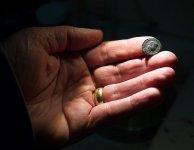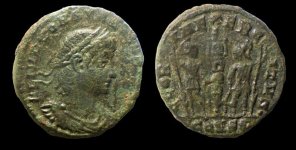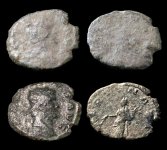I just finished cleaning and identifying a lovely tiny Roman from emperor Constantius II, minted in the first half of the 4th century. This is called an “AE4” which stands for Bronze coin size 4. Roman and other ancient coins are frequently loosely identified by composition and size, since we really don't know the actual names of denominations of Roman (and Greek, Byzantine, Seleucid, Judean, etc) coins. So, the composition will be either AE, for copper/bronze, AR, for silver (and silver mixes called Billon), and AU for Gold. The sizes run from #2, which is 21-25mm, #3, which is 17-21mm, and #4, which is smaller than 17mm.

These very small coins were very popular, but their size also made them more susceptible to bronze disease. Very few are found in good condition. Additionaly, their tiny size makes them difficult to detect and they frequently indicate as iron trash on the detectors. Many of my fellow hunters often throw these away. I have lots that are too far eroded to be worthy cleaning. So when I get one that is in great shape I love them! They are not valuable, but I really like the tiny size and level of detail they were able to create at a time long before the microscope was invented. I have heard that the Roman die makers used a glass sphere filled with water as a magnifying glass.
Additionally what makes this specific coin interesting to me is that I can see traces of silver on the surface. The Romans used to coat their bronze coins with a thin layer of silver that easily wore off. I have never seen a small AE4 size bronze with silver on it before.
- Constantius II, AE4 - 333-336 AD.
- Obverse: FL IVL CONSTANTIVS NOB C, laureate, draped and cuirassed bust right
- Reverse: GLOR-IA EXERC-ITVS dot, two soldiers, each holding spear and shield, one standard between them. Mintmark CONSS (Constantinople).
"FL IVL CONSTANTIUS NOB C" translates to "Flavius Julius Constantius: Noble Caesar". The fact that the coin lists him as Caesar (prince) indicates it must have minted before his father's death in 337.
"GLORIA EXERCITUS" transaltes as "(to) The Glory of the Army".

Constantius II
Constantius II (Latin: Flavius Julius Constantius Augustus; 7 August 317 – 3 November 361) was Roman Emperor from 337 to 361. He was born in my good friend Marcus's home-town of Sirmium (Modern day Sremska Mitrovica, Serbia). The second son of Constantine I and Fausta, he ascended to the throne with his two brothers Constantine II and Constans upon their father's death in 337.
In 340, Constantius' brothers clashed over the western provinces of the Roman empire. The resulting conflict left Constantine II dead and Constans as ruler of the west until he was overthrown and assassinated in 350 by the usurper Magnentius. Unwilling to accept Magnentius as co-ruler, Constantius defeated him at the battles of Mursa Major and Mons Seleucus. Magnentius committed suicide after the latter, leaving Constantius II as sole ruler of the empire.
His subsequent military campaigns against Germanic tribes were successful. He defeated the Alamanni in 354 and campaigned across the Danube in modern day Hungary against the barbarian (Germanic) tribes of the Quadi and Sarmatians in 357.
In 351, due to the difficulty of managing the empire alone, Constantius elevated his cousin Constantius Gallus to the subordinate rank of Caesar, but had him executed three years later after receiving scathing reports of his violent and corrupt nature. Shortly thereafter, in 355, Constantius promoted his last surviving cousin, Julian, to the rank of Caesar. However, Julian claimed the rank of Augustus (Supreme Emperor) in 360, leading to war between the two. Ultimately, no battle was fought as Constantius became feverish, and died late in 361, though not before naming his Julian as his successor.
The story of the Constantine brats would have made a great soap opera.
Here are some of his Christian-related edicts issued by Constantius (by himself or with others) included:
- Exemption from compulsory public service for the clergy;
- Exemption from compulsory public service for the sons of clergy;
- Tax exemptions for clergy and their servants, and later for their family;
- Clergy and the issue of private property;
- Bishops exempted from being tried in secular courts;
- Christian prostitutes only able to be bought by Christians.
Conversely, he was quite anti-Semitic. Some Jewish-related edicts issued by Constantius (by himself or with others) include:
- Weaving-women who moved from working for the government to working for Jews, must be restored to the government
- Jews may not marry Christian women
- Jews may not attempt to convert Christian women;
- Any non-Jewish slave bought by a Jew will be confiscated by the state
- if a Jew attempts to circumcise a non-Jewish slave, the slave will be freed and the Jew shall face capital punishment;
- any Christian slaves owned by a Jew will be taken away and freed;
- A person who is proven to have converted from Christianity to Judaism shall have their property confiscated by the state.
(Coin found with White's V3i in plowed field, using custom Roman Coin program)

These very small coins were very popular, but their size also made them more susceptible to bronze disease. Very few are found in good condition. Additionaly, their tiny size makes them difficult to detect and they frequently indicate as iron trash on the detectors. Many of my fellow hunters often throw these away. I have lots that are too far eroded to be worthy cleaning. So when I get one that is in great shape I love them! They are not valuable, but I really like the tiny size and level of detail they were able to create at a time long before the microscope was invented. I have heard that the Roman die makers used a glass sphere filled with water as a magnifying glass.
Additionally what makes this specific coin interesting to me is that I can see traces of silver on the surface. The Romans used to coat their bronze coins with a thin layer of silver that easily wore off. I have never seen a small AE4 size bronze with silver on it before.
- Constantius II, AE4 - 333-336 AD.
- Obverse: FL IVL CONSTANTIVS NOB C, laureate, draped and cuirassed bust right
- Reverse: GLOR-IA EXERC-ITVS dot, two soldiers, each holding spear and shield, one standard between them. Mintmark CONSS (Constantinople).
"FL IVL CONSTANTIUS NOB C" translates to "Flavius Julius Constantius: Noble Caesar". The fact that the coin lists him as Caesar (prince) indicates it must have minted before his father's death in 337.
"GLORIA EXERCITUS" transaltes as "(to) The Glory of the Army".

Constantius II
Constantius II (Latin: Flavius Julius Constantius Augustus; 7 August 317 – 3 November 361) was Roman Emperor from 337 to 361. He was born in my good friend Marcus's home-town of Sirmium (Modern day Sremska Mitrovica, Serbia). The second son of Constantine I and Fausta, he ascended to the throne with his two brothers Constantine II and Constans upon their father's death in 337.
In 340, Constantius' brothers clashed over the western provinces of the Roman empire. The resulting conflict left Constantine II dead and Constans as ruler of the west until he was overthrown and assassinated in 350 by the usurper Magnentius. Unwilling to accept Magnentius as co-ruler, Constantius defeated him at the battles of Mursa Major and Mons Seleucus. Magnentius committed suicide after the latter, leaving Constantius II as sole ruler of the empire.
His subsequent military campaigns against Germanic tribes were successful. He defeated the Alamanni in 354 and campaigned across the Danube in modern day Hungary against the barbarian (Germanic) tribes of the Quadi and Sarmatians in 357.
In 351, due to the difficulty of managing the empire alone, Constantius elevated his cousin Constantius Gallus to the subordinate rank of Caesar, but had him executed three years later after receiving scathing reports of his violent and corrupt nature. Shortly thereafter, in 355, Constantius promoted his last surviving cousin, Julian, to the rank of Caesar. However, Julian claimed the rank of Augustus (Supreme Emperor) in 360, leading to war between the two. Ultimately, no battle was fought as Constantius became feverish, and died late in 361, though not before naming his Julian as his successor.
The story of the Constantine brats would have made a great soap opera.
Here are some of his Christian-related edicts issued by Constantius (by himself or with others) included:
- Exemption from compulsory public service for the clergy;
- Exemption from compulsory public service for the sons of clergy;
- Tax exemptions for clergy and their servants, and later for their family;
- Clergy and the issue of private property;
- Bishops exempted from being tried in secular courts;
- Christian prostitutes only able to be bought by Christians.
Conversely, he was quite anti-Semitic. Some Jewish-related edicts issued by Constantius (by himself or with others) include:
- Weaving-women who moved from working for the government to working for Jews, must be restored to the government
- Jews may not marry Christian women
- Jews may not attempt to convert Christian women;
- Any non-Jewish slave bought by a Jew will be confiscated by the state
- if a Jew attempts to circumcise a non-Jewish slave, the slave will be freed and the Jew shall face capital punishment;
- any Christian slaves owned by a Jew will be taken away and freed;
- A person who is proven to have converted from Christianity to Judaism shall have their property confiscated by the state.
(Coin found with White's V3i in plowed field, using custom Roman Coin program)



